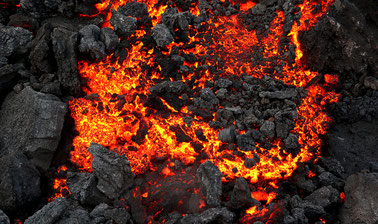
The course gives an introduction to volcano monitoring techniques, magma movements and volcano unrest. It also presents some aspects of why volcanoes are dangerous and volcanic hazards. Volcano monitoring relies on diverse approaches to infer the state of a volcano so many different instruments and techniques are used to monitor volcanoes. Predicting eruptions or forecasting future activity of a volcano is based on monitoring data. If activity level rises above normal the volcano is in a state of unrest. Magma often intrudes in the roots of volcanoes prior to eruptions. This process generates earthquakes as stress level is increased and ground deformation as the volcano expands in response to additional mass in its subsurface. Seismology and geodetic measurements on the surface of the volcano are thus key to monitoring subsurface conditions.
Read more
The course gives an introduction to volcano monitoring techniques, magma movements and volcano unrest. It also presents some aspects of why volcanoes are dangerous and volcanic hazards. Volcano monitoring relies on diverse approaches to infer the state of a volcano so many different instruments and techniques are used to monitor volcanoes. Predicting eruptions or forecasting future activity of a volcano is based on monitoring data. If activity level rises above normal the volcano is in a state of unrest. Magma often intrudes in the roots of volcanoes prior to eruptions. This process generates earthquakes as stress level is increased and ground deformation as the volcano expands in response to additional mass in its subsurface. Seismology and geodetic measurements on the surface of the volcano are thus key to monitoring subsurface conditions.
The course gives an introduction to volcano monitoring techniques, magma movements and volcano unrest. It also presents some aspects of why volcanoes are dangerous and volcanic hazards. Volcano monitoring relies on diverse approaches to infer the state of a volcano so many different instruments and techniques are used to monitor volcanoes. Predicting eruptions or forecasting future activity of a volcano is based on monitoring data. If activity level rises above normal the volcano is in a state of unrest. Magma often intrudes in the roots of volcanoes prior to eruptions. This process generates earthquakes as stress level is increased and ground deformation as the volcano expands in response to additional mass in its subsurface. Seismology and geodetic measurements on the surface of the volcano are thus key to monitoring subsurface conditions.
As magma, molten rock inside volcanoes, approaches the surface it releases volcanic gas that finds its way to the surface, and geothermal activity can change. In addition to ground-based techniques, satellite observations are extensively used. The main monitoring techniques for volcanoes are explained in the course, with the aim that students understand both the concept of volcanic unrest and how it can be monitored, how eruptions can be monitored, and signs of volcanic eruptions as seen on instruments.
Understanding the possibilities and limitations of present-day volcano monitoring for detecting magma movements is an important step in understanding volcanoes, evaluating hazards and for giving warnings of impending eruptions. The course thus provides information on how scientists predict future activity of volcanoes and volcanic eruptions. Monitoring data are interpreted in terms of models of subsurface processes such as magma accumulation during volcano unrest, and magma withdrawal during eruptions. The course gives an introduction to such models, used to infer the volume and location of magma movements in volcano roots, in particular those based on mapping ground deformation.
The course presents examples of monitoring data and interpretations from recent eruptions and periods of volcanic unrest in Iceland and around the world, including the 2010 eruption of Eyjafjallajökull that closed Europe’s airspace.
What you'll learn
- Develop an understanding of volcanic plumbing systems and magma movements in volcanoes.
- Develop an understanding of the concept of volcanic unrest.
- Become familiar with volcano monitoring techniques.
- Understand how seismology is used to study volcano earthquakes.
- Understand how volcano geodesy is used to map ground deformation on volcanoes.
- Understand what volcanic gas tells us about magma movements.
- Understand what produces variations in geothermal activity on volcanoes.
- Understand how satellites can be used effectively to map changes on volcanoes.
- Develop an understanding of key properties of magma relevant to volcano models.
- Develop an understanding of how eruptions are monitored and how eruption rates can be evaluated.
- Develop an understanding of models used to interpret volcano deformation, including response to a pressure increase in a spherical source (the Mogi model).
- Develop an understanding of how volcano observations are fit to models.
- Gain knowledge about a number of volcanic unrest periods and eruptions in Iceland and elsewhere.
- Gain knowledge about how to design a volcano monitoring network and use monitoring data to mitigate the influence of volcanic hazards.
What's inside
Learning objectives
- Develop an understanding of volcanic plumbing systems and magma movements in volcanoes.
- Develop an understanding of the concept of volcanic unrest.
- Become familiar with volcano monitoring techniques.
- Understand how seismology is used to study volcano earthquakes.
- Understand how volcano geodesy is used to map ground deformation on volcanoes.
- Understand what volcanic gas tells us about magma movements.
- Understand what produces variations in geothermal activity on volcanoes.
- Understand how satellites can be used effectively to map changes on volcanoes.
- Develop an understanding of key properties of magma relevant to volcano models.
- Develop an understanding of how eruptions are monitored and how eruption rates can be evaluated.
- Develop an understanding of models used to interpret volcano deformation, including response to a pressure increase in a spherical source (the mogi model).
- Develop an understanding of how volcano observations are fit to models.
- Gain knowledge about a number of volcanic unrest periods and eruptions in iceland and elsewhere.
- Gain knowledge about how to design a volcano monitoring network and use monitoring data to mitigate the influence of volcanic hazards.
- Develop an understanding of volcanic plumbing systems and magma movements in volcanoes.
- Develop an understanding of the concept of volcanic unrest.
- Become familiar with volcano monitoring techniques.
- Understand how seismology is used to study volcano earthquakes.
- Understand how volcano geodesy is used to map ground deformation on volcanoes.
- Understand what volcanic gas tells us about magma movements.
- Understand what produces variations in geothermal activity on volcanoes.
- Understand how satellites can be used effectively to map changes on volcanoes.
- Develop an understanding of key properties of magma relevant to volcano models.
- Develop an understanding of how eruptions are monitored and how eruption rates can be evaluated.
- Develop an understanding of models used to interpret volcano deformation, including response to a pressure increase in a spherical source (the mogi model).
- Develop an understanding of how volcano observations are fit to models.
- Gain knowledge about a number of volcanic unrest periods and eruptions in iceland and elsewhere.
- Gain knowledge about how to design a volcano monitoring network and use monitoring data to mitigate the influence of volcanic hazards.
Syllabus
Module 1 : Introduction, volcanic plumbing systems and volcano seismology. We explore models of volcano interiors and how magma (molten rocks) finds its way to the surface, often through a complicated volcanic plumbing system. We learn about how seismology can track earthquakes due to magma movements and increased stress in volcano roots.
Read more
Syllabus
Good to know
Save this course
Reviews summary
Highly rated volcano course
Activities
Review the book "Volcanoes: A Primer" by Robert Decker and Barbara Decker
Show steps
This book provides a comprehensive overview of volcanoes and volcanic processes.
View
Volcanoes
on Amazon
Show steps
-
Read the book
-
Take notes on the key concepts
-
Discuss the book with classmates or the instructor
Review basic geology
Show steps
Volcanic plumbing systems and deformation are built on basic geological concepts.
Browse courses on
Geology
Show steps
-
Review the rock cycle and plate tectonics
-
Study different types of rocks and their properties
-
Learn about geological structures such as faults and folds
Practice interpreting volcano monitoring data
Show steps
Interpreting volcano monitoring data is a critical skill for volcanologists.
Show steps
-
Find a dataset of volcano monitoring data
-
Choose a data visualization tool
-
Plot the data and identify any trends or patterns
-
Interpret the data and make predictions about future volcanic activity
One other activity
Expand to see all activities and additional details
Show all four activities
Create a study guide for the course
Show steps
A study guide can help organize and review course materials to better prepare for assessments.
Show steps
-
Gather all of the course materials
-
Organize the materials by topic
-
Create a study guide that includes key concepts, definitions, and practice questions
Review the book "Volcanoes: A Primer" by Robert Decker and Barbara Decker
Show steps
This book provides a comprehensive overview of volcanoes and volcanic processes.
View
Volcanoes
on Amazon
Show steps
- Read the book
- Take notes on the key concepts
- Discuss the book with classmates or the instructor
Review basic geology
Show steps
Volcanic plumbing systems and deformation are built on basic geological concepts.
Browse courses on
Geology
Show steps
- Review the rock cycle and plate tectonics
- Study different types of rocks and their properties
- Learn about geological structures such as faults and folds
Practice interpreting volcano monitoring data
Show steps
Interpreting volcano monitoring data is a critical skill for volcanologists.
Show steps
- Find a dataset of volcano monitoring data
- Choose a data visualization tool
- Plot the data and identify any trends or patterns
- Interpret the data and make predictions about future volcanic activity
Create a study guide for the course
Show steps
A study guide can help organize and review course materials to better prepare for assessments.
Show steps
- Gather all of the course materials
- Organize the materials by topic
- Create a study guide that includes key concepts, definitions, and practice questions
Career center
Volcanologist
Geophysicist
Geodetic Surveyor
Seismologist
Volcano Monitoring Technician
Natural Hazards Manager
GIS Analyst
Emergency Manager
Science Writer
Geologist
Environmental Scientist
Teacher
Laboratory Technician
Database Administrator
Business Analyst
Reading list
Share
Similar courses
OpenCourser helps millions of learners each year. People visit us to learn workspace skills, ace their exams, and nurture their curiosity.
Our extensive catalog contains over 50,000 courses and twice as many books. Browse by search, by topic, or even by career interests. We'll match you to the right resources quickly.
Find this site helpful? Tell a friend about us.
We're supported by our community of learners. When you purchase or subscribe to courses and programs or purchase books, we may earn a commission from our partners.
Your purchases help us maintain our catalog and keep our servers humming without ads.
Thank you for supporting OpenCourser.



